

Biocultural. Chemicals. DNA. Drugs. Environmental. Examples of Uses. Ethnobotany. Forensics. Herbivory. Infection. Invasive Species. Miscellaneous. Species Distribution. Taxonomy. Grinnell Resurvey Project. Recent News Grinnell Resurvey Project receives funding from the National Science Foundation and the National Geographic Society in mid-2015 to conduct resurveys in California desert parks.
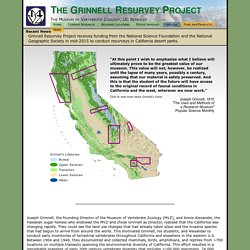
Resurveys of birds in California's Central Valley initiated in summer 2015. Resurvey Before and After Photos. Just Accepted and OA @IJPSJournal: Coulter Review: Herbaria as Big Data Sources of Plant Traits @jmheberling. Trait data from plant individuals across heterogeneous sources. 1.
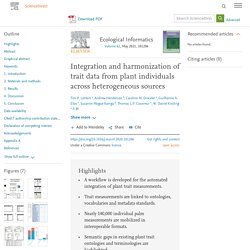
Introduction The integration and harmonization of data from heterogeneous sources is one of the biggest challenges in current ecological research (Farley et al., 2018). Improving Checklists of Alien Plants with Digitised Herbarium Collections: The Example of D.R. Congo (Africa) - Abstract. The Democratic Republic of the Congo (D.R.
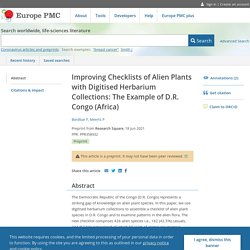
Congo) represents a striking gap of knowledge on alien plant species. In this paper, we use digitised herbarium collections to assemble a checklist of alien plant species in D.R. Congo and to examine patterns in the alien flora. The new checklist comprises 426 alien species i.e., 182 (42.5%) casuals, 244 (57.5%) naturalised of which 80 (19% of aliens) are invasive. Herbaria are a last resource for resurrecting extinct or critically endangered Hawaiian plants. @NTBG tested seeds from 138 specimens of 37 Hawaiian plants in our herbarium - 7 not represented in any seed bank. 3 species germinated - a last resort - seed. When researchers #CiteTheDOI, they make it possible for scientific consortia and collections to demonstrate tangible outcomes and impacts of all the effort they put into making #OpenData on #biodiversity freely and openly available!
Uses and benefits of digital sequence information from plant genetic resources: Lessons learnt from botanical collections - Cowell - The use of large-scale molecular assays, particularly the determination of DNA sequences, has revolutionized biology in recent decades (Kersey et al., 2020).
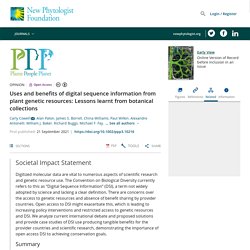
Critical to this has been the sharing of sequence information, allowing the inference of evolutionary relationships, population dynamics, and gene function from the comparison of multiple sequences. Digital Sequence Information (DSI) in combination with other data, such as predictive climate models, provides the foundation for finding nature-based solutions to the global challenges we face (Antonelli et al., 2020). For example, as climate changes, it is probable that different countries will need to grow different crops, and scientific research is needed now to identify genes conferring novel traits, and potentially novel crop species, from the wild relatives of existing crops (Borrell et al., 2020).
Phenological change modelling for selected Himalayan medicinal herbs using herbarium records: A case study. Checklist of Kilimanjaro grasses shows that both plot and herbarium methods are necessary to record diversity. Agrawala, S., Moehner, A., Hemp, A., van Aalst, M., Hitz, S., Smith, J., Meena, H., Mwakifwamba, S.M., Hyera, T.
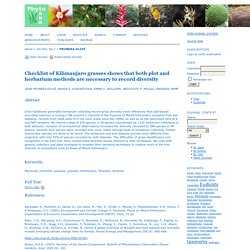
& Mwaipopo, O.U. (2003) Development and Climate Change in Tanzania: Focus on Mount Kilimanjaro. Organization of Economic Cooperation and Development (OECD), Paris, 72 pp. Allen, C.D., Macalady, A.K., Chenchouni, H., Bachelet, D., McDowell, N., Vennetier, M., Kitzberger, T., Rigling, A., Breshears, D.D., Hogg, E.H., Gonzalez, P., Fensham, R., Zhang, Z., Castro, J., Demidova, N., Lim, J. -H., Allard, G., Running, S.W., Semerci, A. & Cobb, N. (2010) A global overview of drought and heat-induced tree mortality reveals emerging climate change risks for forests. Forest Ecology and Management 259 (4): 660–684. Natural History Collections: Advancing the Frontiers of Science. Natural history collections – whether a natural history museum, botanical garden, herbaria, tissue collection, university-based biodiversity collection, or a living stock collection – are a global network of research institutions and affiliated scientists and educators that are a foundation for interdisciplinary and global research and education.
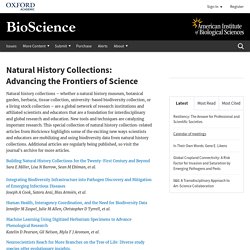
New tools and techniques are catalyzing important research. This special collection of natural history collection-related articles from BioScience highlights some of the exciting new ways scientists and educators are mobilizing and using biodiversity data from natural history collections. Additional articles are regularly being published, so visit the journal's archive for more articles. Applications in Plant Sciences. Fungi constitute a hyperdiverse kingdom representing an array of ecological lifestyles, including human pathogens, ectomycorrhizae, lichens, and many more (Burgess et al., 2006; Blackwell, 2011; Li et al., 2016; Medeiros et al., 2017; Crossay et al., 2018; Chang et al., 2019; Mujic et al., 2019).

Due to their fundamentally microscopic nature and their usually ephemeral reproductive structures (e.g., mushrooms, apothecia, etc.), the identification of fungi has historically been exceptionally difficult, relying on often artificial groupings based on limited morphological features. The advent and maturation of molecular approaches has revolutionized mycology; in the past two decades, a significant number of new orders, classes, and even phyla have been described (Schüβler et al., 2001; Zalar et al., 2005; Hosaka et al., 2006; Schoch et al., 2009; Rosling et al., 2011; Hodkinson et al., 2014).
The results of the BLAST analysis are included in Appendix S1. Acknowledgments Open Research. Scientists Use Century-Old Seaweed to Solve a Marine Mystery. There are few things I enjoy more than turning a slimy piece of seaweed into a work of art.
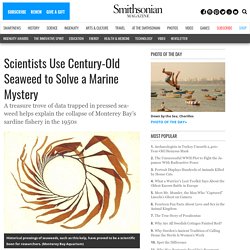
From scouring the tide pools for the perfect blades, to artfully arranging them on a piece of paper in my herbarium press, every step of the process is immensely satisfying. Using the same technique that people use to press flowers, I can turn almost any algae into a natural work of art that can last for centuries. Although I press algae for artistic purposes, algae pressing has long been a scientific pursuit. The practice emerged in 19th-century England as a way for scientists and natural history buffs to preserve and catalog the diverse array of seaweeds found along the country’s coasts. Women were among the most avid algae pressers. Plastome sequencing of a 167-year-old herbarium specimen and classical morphology resolve the systematics of two potentially extinct grass species.
Sequencing of a 167yo herbarium specimen has finally resolved a longstanding 'dustbin' group in the grasses. The work is part of a trend of increasingly ambitious genetic work on old specimens. My latest for Botany One. #iamabotanist. Systematics of extinct grass species resolved with sequencing of 167-year-old herbarium specimen. With new technology and techniques leading to new specimen uses and means for analysis, natural history collections are only becoming more valuable as time goes by.

Limitations in sequencing technology had until recently made sequencing very old herbarium specimens next to impossible. Advances in next generation sequencing (NGS) are continually pushing back the age at which samples are still viable, opening up avenues for the analysis of type specimens and recently extinct taxa that are over a century and a half old. This work has the potential to refine the systematics of numerous groups. In a new article published in the Botanical Journal of the Linnean Society, lead author Laurent Hardion of the University of Strasbourg and colleagues used NGS to sequence the whole plastid genome of a 167-year-old herbarium specimen of Leptagrostis schimperiana.
The possibly extinct Philippine pitcher plant. AUS: Tracking data usage: ecology, ed, cit sci. Abstract Premise of the Study Globally, natural history collections are focused on digitizing specimens and information and making these data accessible.
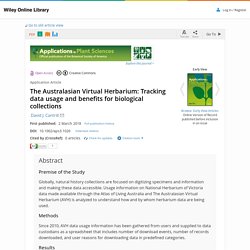
Usage information on National Herbarium of Victoria data made available through the Atlas of Living Australia and The Australasian Virtual Herbarium (AVH) is analyzed to understand how and by whom herbarium data are being used. Methods Since 2010, AVH data usage information has been gathered from users and supplied to data custodians as a spreadsheet that includes number of download events, number of records downloaded, and user reasons for downloading data in predefined categories. Herbarium data: Global biodiversity and societal botanical needs for novel research - James - 2018 - Applications in Plant Sciences. Building on centuries of research based on herbarium specimens gathered through time and around the globe, a new era of discovery, synthesis, and prediction using digitized collections data has begun.
This paper provides an overview of how aggregated, open access botanical and associated biological, environmental, and ecological data sets, from genes to the ecosystem, can be used to document the impacts of global change on communities, organisms, and society; predict future impacts; and help to drive the remediation of change. Advocacy for botanical collections and their expansion is needed, including ongoing digitization and online publishing. Areas of plant diversity—What do we know? - Brummitt - Over 200 years ago the geographer and naturalist Alexander von Humboldt, exploring the New World with the botanist Aimé Bonpland, famously wrote home to his brother from Venezuela in 1799 to say that he and Bonpland “… rush around like the demented, in the first 3 days we were unable to classify anything … Bonpland assures me he will go mad if the wonders do not cease soon” (Stearn, 1988).
Since this time it has long been recognized that tropical regions house the greatest diversity of plant species, the new discovery of which will continue for many years into the future (Joppa, Roberts, Myers, & Pimm, 2011). The following 19th century is widely considered to have been the high water mark of biological exploration, as first European and later local scientists and explorers pressed ever further into remote regions. Herbarium specimens' varied uses. While some might press flowers into books to preserve their beauty, researcher Mark Whitten does it to preserve history. Whitten, a botanist in the Florida Museum of Natural History Herbarium, glues pressed plants onto archival paper and stores them as specimens in the museum’s collection. He said herbarium specimens show data about plants’ location, habitat, flowers and fruits at the time of their collection. With this information, researchers are starting to make connections about recent climate change and its influence on the seasonal cycles of plants, or plant phenology.
Whitten said researchers lack good observational records on when plants start to flower, produce fruit or form leaves, which is where herbarium specimens come in. A special journal explains the critical importance of biological collections. Tropical Plant Collections: Legacies from the Past? Essential Tools for the Future? Henrik Balslev and Ib Friis, Editors. Ep. 169 - Herbaria Are Data Gold Mines. Phenology, population size, distribution, genetic diversity - these are just some of the data locked up in herbaria around the globe. My guest today is Katelin Pearson and she has been working hard on making sure herbarium data are as available as they can be to everyone from scientists to artists, and even the general public.
As you will hear, we herbaria succeed, so do the plants they help understand. Digital Collections Programme – Blogs from the Natural History Museum. There is an incredible amount of specimen data providing critical information on the natural world, but with less than 10% of the estimated 1.5 billion specimens digitally accessible, who is using this information? This blog provides a brief overview of how the Museum’s digital collection sits within the wider landscape of efforts to digitise our collections and some insight into how these data are making an impact on the wider scientific community. The Museum’s Data Portal currently holds over 4.3 million specimen records from the Museum collection. One of the major destinations of this data is the Global Biodiversity Information Facility (GBIF), an international network and research infrastructure that provides free and open access to the world’s biodiversity data. Green digitization: Botanical collections data answer real-world questions.
Good Argument for Herbaria; there uses. Herbarium Samples in Evolutionary Botany. Harvesting Collections for Social Benefit: Hidden Stories at the Herbarium of RBGE. Editorial: Integrative and Translational Uses of Herbarium Collections Across Time, Space, and Species. Frontiers in Plant Science. On the identity and typification of Solanum brasilianum Dunal (Solanaceae)
Botanists Use Data Collected by Thoreau to Uncover Unexpected Effects of Climate Change - Carnegie Museum of Natural History. Harris Plant lists and herbarium collections. Herbarium: An Echo of a Past Love. NHM Botany sur Twitter : "The Reverend Adam Buddle's #herbarium specimen of Equisetum ramosissimum pushed back the first British record of this plant by over 250yrs. Cystopteris diaphana was first considered a British wild plant in 2000. Buddle's specimen. Stories from California Herbaria. 50-Year-Old Biology Collection Enables New Research Opportunities.